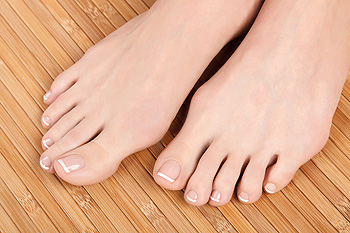 There are twenty-six bones in each foot, and the cuboid bone is located on the outside edge below the ankle. The condition that is known as cuboid syndrome can occur as a result of overstretched or torn tendons which connect to the cuboid bone. It can be a common ailment among people who frequently participate in running and jumping activities, and cause pain and discomfort. Common symptoms that can be associated with cuboid syndrome can consist of a dull ache when this condition occurs from repetitive strain. If a sudden injury occurs, a sharp pain is immediately felt, and it may be difficult to walk. Effective treatment can consist of resting the affected foot, followed by introducing techniques that can return the tendons to their normal alignment. If you are experiencing pain in the outside of your foot, it is suggested that you consult with a podiatrist who can properly diagnose cuboid syndrome.
There are twenty-six bones in each foot, and the cuboid bone is located on the outside edge below the ankle. The condition that is known as cuboid syndrome can occur as a result of overstretched or torn tendons which connect to the cuboid bone. It can be a common ailment among people who frequently participate in running and jumping activities, and cause pain and discomfort. Common symptoms that can be associated with cuboid syndrome can consist of a dull ache when this condition occurs from repetitive strain. If a sudden injury occurs, a sharp pain is immediately felt, and it may be difficult to walk. Effective treatment can consist of resting the affected foot, followed by introducing techniques that can return the tendons to their normal alignment. If you are experiencing pain in the outside of your foot, it is suggested that you consult with a podiatrist who can properly diagnose cuboid syndrome.
Cuboid syndrome, also known as cuboid subluxation, occurs when the joints and ligaments near the cuboid bone in the foot become torn. If you have cuboid syndrome, consult with Dr. Derek T. Pantiel from Summit Podiatry. Our doctor will assess your condition and provide you with quality foot and ankle treatment.
Cuboid syndrome is a common cause of lateral foot pain, which is pain on the outside of the foot. The condition may happen suddenly due to an ankle sprain, or it may develop slowly overtime from repetitive tension through the bone and surrounding structures.
Causes
The most common causes of cuboid syndrome include:
- Injury – The most common cause of this ailment is an ankle sprain.
- Repetitive Strain – Tension placed through the peroneus longus muscle from repetitive activities such as jumping and running may cause excessive traction on the bone causing it to sublux.
- Altered Foot Biomechanics – Most people suffering from cuboid subluxation have flat feet.
Symptoms
A common symptom of cuboid syndrome is pain along the outside of the foot which can be felt in the ankle and toes. This pain may create walking difficulties and may cause those with the condition to walk with a limp.
Diagnosis
Diagnosis of cuboid syndrome is often difficult, and it is often misdiagnosed. X-rays, MRIs and CT scans often fail to properly show the cuboid subluxation. Although there isn’t a specific test used to diagnose cuboid syndrome, your podiatrist will usually check if pain is felt while pressing firmly on the cuboid bone of your foot.
Treatment
Just as the range of causes varies widely, so do treatments. Some more common treatments are ice therapy, rest, exercise, taping, and orthotics.
If you have any questions, please feel free to contact one of our offices located in Wilmington, Whiteville, and Burgaw, NC . We offer the newest diagnostic and treatment technologies for all your foot care needs.
Read more about Cuboid Syndrome
